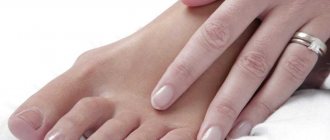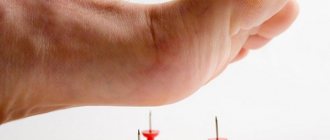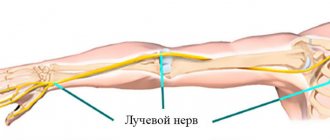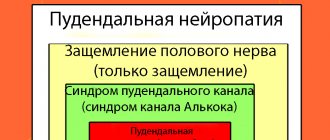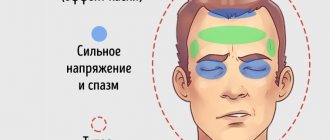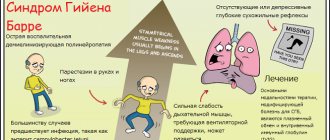- Dizziness
- Cardiopalmus
- Weakness in the legs
- Convulsions
- Sweating
- Weakness in the hands
- Constipation
- Swelling of the limbs
- Trembling limbs
- Creepy crawling sensation
- Pain in the affected area
- Breathing problems
- Decreased tendon reflexes
- Unsteady gait
- Decreased sensitivity in certain areas of the body
Polyneuropathy is a group of diseases that affects a large number of nerve endings in the human body. The disease has various causes. The factors that cause the onset of the disease first of all irritate the nerve fibers, and only then lead to disruption of their functioning. Characteristic signs of the disease are muscle weakness and pain in the affected area of the body.
- Etiology
- Varieties
- Symptoms
- Complications
- Diagnostics
- Treatment
- Prevention
The disease manifests itself as paralysis, impaired sensitivity to tactile touch, and various disorders in the functioning of the upper and lower extremities of the human body. The signs of the disease and the intensity of their manifestation completely depend on the form and type of the disease. Typically, polyneuropathy causes a lot of suffering to patients, and treatment is protracted. The course of the disease is progressive and the process can become chronic. Most often, this disease occurs in the lower parts of the body.
Polyneuropathy can occur in a sluggish form, and also have fulminant development.
Causes of the disease
The causes of polyneuropathy are varied. The main ones include:
- poisoning with pure alcohol, gas, arsenic (chemical poisoning);
- chronic diseases (diabetes, diphtheria);
- systemic pathologies of the body;
- long-term use of certain groups of pharmaceuticals;
- alcoholism;
- impaired immunity;
- hereditary factor;
- metabolic disorder;
- HIV infection.
The pathology may be of the following nature:
- inflammatory. In this case, intense inflammation of the nerve fibers is observed;
- toxic. Develops due to the ingestion of large amounts of toxic substances into the body;
- allergic;
- traumatic.
Nowadays, the most common type is diabetic polyneuropathy. It is worth noting that polyneuropathy is a rather dangerous pathology that requires timely and adequate treatment. If it is not there, the progression of the disease can lead to muscle atrophy and the appearance of ulcers. The most dangerous complication is paralysis of the legs or arms, and then the breathing muscles.
Nerve damage due to polyneuropathy
Kinds
Doctors distinguish the following types of polyneuropathies:
- Inflammatory (arising as a result of inflammatory processes in the nervous tissue);
- Toxic (caused by poisoning of the body with some toxic agent - for example, lead);
- Allergic (resulting from failures of the body's defense mechanisms);
- Traumatic (appearing as a result of traumatic lesions).
Polyneuropathies can be chronic and acute, as well as axonal (characterized by damage to the axial cylinder of the nerve fiber) and demyelinating (developing as a result of pathology of the myelin sheath of the fibers).
Causes
The disease can be caused by many reasons, which are not always clear. The main factors influencing the development of polyneuropathy are:
- Poisoning of the body - industrial (lead, arsenic, mercury) or food (poor quality food, alcohol, drugs);
- Bacterial or viral infections causing inflammation in peripheral nerves;
- Diseases of the kidneys, pancreas and liver;
- Endocrine diseases (diabetes, thyroid lesions);
- Vitamin deficiencies;
- Uncontrolled use of certain medications (these include bismuth salts, antibiotics);
- Hereditary (genetic) causes;
- Tumors;
- Autoimmune processes (immune system disorders that occur as a result of internal failures in the body).
Polyneuropathy most often occurs in the lower extremities due to the fact that the distal (remote) sections of the nerves are the first to respond to various pathological processes in the body, and also because the distant nerves do not have a blood-brain barrier, and infectious and other damaging agents penetrate from the blood directly into the nervous system. textile.
Varieties
According to the mechanism of damage, the disease is divided into the following types:
- demyelinating polyneuropathy. The development of the disease is associated with the breakdown of a protein in the body that envelops the nerves and is responsible for the high speed of impulses carried through them;
- axonal. This type is associated with a disruption in the functioning of the nerve core. This type is accompanied by difficult treatment and long recovery;
- neuropathic. With it, damage is observed directly to the bodies of nerve cells;
- diphtheria and diabetic polyneuropathy;
- polyneuropathy of the lower extremities;
- alcoholic polyneuropathy.
According to the primacy of nerve damage, polyneuropathy occurs:
- sensory. Manifests itself in the form of numbness or pain;
- motor. Motor fibers are affected, which is accompanied by muscle weakness;
- sensory-motor. Characteristic symptoms of damage are decreased sensitivity and motor activity of muscle structures;
- vegetative. There is a disruption in the functioning of internal organs due to inflammation of the nerves;
- mixed. Includes all the characteristics of the types described above;
- polyneuropathy of the lower extremities.
Depending on the cause of development, polyneuropathy can be:
- idiopathic. The occurrence is associated with disturbances in the functioning of the immune system;
- hereditary. Passed on from one generation to another;
- dismetabolic. Progresses due to metabolic disorders;
- toxic polyneuropathy develops from toxic substances entering the body;
- post-infectious. Occurs during infectious processes in the body;
- paraneoplastic. Development occurs in conjunction with cancer;
- in diseases of the body, develops as part of the disease;
- alcoholic polyneuropathy.
According to the nature of the flow:
- spicy. Development time is from two to four days. Treatment lasts several weeks;
- subacute Develops in a few weeks, treatment takes months;
- chronic. It progresses over six months or more, and has an individual treatment term for each person.
Diabetic polyneuropathy
Polyneuropathy: what is it and what types are there?
From Greek, this pathology is translated as “disease of many nerves,” which accurately reflects the essence of the disease. During its development, almost all nerves of the peripheral system are affected, which leads to weakening of muscle tissue, decreased sensitivity and impaired reflexes (sometimes they are completely absent).
As already noted above, there are many reasons that provoke the development of polyneuropathy. Not only the treatment, but also the nature of possible complications depends on this. There are 5 types of disease:
- sensory;
- motor;
- sensorimotor;
- vegetative;
- mixed.
Sensory
It mainly affects the peripheral nerves of the lower extremities. The clinical picture includes:
- decreased sensitivity;
- tingling or “pins and needles” sensation;
- burning;
- numbness.
The disease develops slowly and it is difficult to suspect its presence in the initial stages. This is the insidiousness of the disease, since the lack of timely treatment leads to the progression of polyneuropathy and irreversible consequences.
Motor
It can affect both peripheral nerves of the lower and upper extremities. The main manifestation of the disease is muscle weakness. It manifests itself as a violation of motor functions, up to the complete inability to move the limbs. Motor polyneuropathy is much more dangerous than sensory polyneuropathy, as it leads to immobility of a person. This causes rapid muscle atrophy, the appearance of ulcers on the body and other complications.
Sensorimotor
This form of pathology is characterized by symptoms of two types of polyneuropathy - sensory and motor. That is, a person experiences not only disturbances in motor functions, but also a decrease in sensitivity, numbness, tingling, etc. Of all types of the disease, this form is diagnosed most often.
Vegetative
It develops with simultaneous damage to vegetative fibers, which causes the following symptoms:
- increased sweating;
- pale skin;
- gastrointestinal disorders;
- dizziness;
- nausea.
Such symptoms indicate the development of several pathologies at once. Therefore, if such signs occur, you should not delay your visit to the doctor.
Mixed
This form of the disease is the most severe, as it includes symptoms of all types of polyneuropathy at once. It is rarely diagnosed, but is often accompanied by serious complications.
Symptoms
Regardless of what type of disease a person has, be it alcoholic or diabetic, hereditary or toxic polyneuropathy or demyelinating, the symptoms are often the same.
A wide range of factors that cause the disease often primarily affect the nerve, and then lead to disruption of their function. The main symptoms of the disease are:
- weakness in the muscles of the arms and legs;
- respiratory disorder;
- decreased reflexes and sensitivity, up to their complete absence;
- prolonged sensation of “goosebumps” all over the skin;
- increased sweating;
- tremors or seizures;
- swelling of the arms and legs;
- cardiopalmus;
- unsteady gait and dizziness;
- constipation
Provoking factors
Various reasons can provoke the development of polyneuropathy. Among them are:
- Diabetes. 40% of diabetics suffer from polyneuropathy. This happens because diabetes mellitus disrupts the functioning of the blood vessels that supply the nerve fibers. As a result, abnormalities in the myelin sheath of the nerves are observed and disorders of the peripheral system occur. When diabetes becomes the cause of polyneuropathy, the lower extremities are most often affected.
- Deficiency of B vitamins. When the body experiences a long-term lack of any of the B vitamins, its functioning is impaired. First of all, the peripheral system suffers, since these substances are involved in the construction of nerve fibers and are responsible for their conductivity.
- Long-term intoxication of the body. Various chemicals can cause poisoning of the body, for example, alcohol, nicotine, inhalation of harmful vapors of gasoline, glue, paint, etc. Also, intoxication often occurs against the background of various infections - herpes, HIV, diphtheria. When poisoning of the body occurs as a result of inhalation of carbon monoxide, arsenic and other chemical fumes, polyneuropathy can develop in literally 2-3 days. If a person has infectious diseases or alcoholism, the first signs of a disturbance in the peripheral system may appear after 1-2 months.
- Injuries. When severe injuries occur, nerve endings can be torn and compressed, which leads to disruption of their functionality. But it should be noted that such consequences are caused not only by injuries, but also by poor-quality surgical interventions, osteochondrosis, intervertebral hernia, etc.
- Guillain-Barre syndrome. It is an autoimmune disease in which the body begins to slowly destroy itself, causing damage to the nerve fibers. The development of Guillain-Barré syndrome is a consequence of severe infectious pathologies.
- Hereditary predisposition. In this case, we are talking about abnormal metabolism, which, as scientists have proven, can be transmitted genetically.
Polyneuropathy can also develop in women during pregnancy. This can happen in any trimester and completely suddenly. The reason for this is several factors:
- long-term toxicosis;
- lack of B vitamins;
- inadequate immune response to pregnancy.
Diagnostics
It will not be possible to independently diagnose any of the above types of polyneuropathy based only on a person’s symptoms (many symptoms are similar to the manifestations of other diseases). If one or more signs are detected, you should consult a doctor as soon as possible. To make a diagnosis, specialists will conduct a wide range of studies, which include:
- initial examination and survey;
- neurological examination and testing of basic nerve reflexes;
- complete blood count;
- radiography;
- Ultrasound;
- biopsy;
- consultation of the patient with specialists such as a therapist and an endocrinologist.
Survey
During the initial appointment of a patient suspected of having polyneuropathy, neurologists conduct a survey, examination, and neurological examination. Doctors at the neurology clinic examine the motor, sensory and autonomic systems.
Then additional tests are prescribed: general and biochemical blood tests, determination of the concentration of vitamin B12 and thyroid-stimulating hormone. Electroneuromyography is performed when there are signs of polyneuropathy, and a thorough clinical and laboratory examination has not revealed the cause of damage to the peripheral nerves. To identify the protein, laboratory technicians perform immunoelectrophoresis of serum proteins.
If paraneoplastic polyneuropathy or systemic connective tissue disease is suspected, neurologists perform additional tests. If a patient has a clinical picture of demyelinating polyradiculoneuropathy and changes are detected during electroneuromyography, doctors at the neurology clinic perform a spinal puncture and send the cerebrospinal fluid for laboratory testing. An increase in protein levels in the cerebrospinal fluid is observed with autoimmune damage to the nerve roots.
An informative laboratory test for autoimmune neuropathies is the determination of antibodies to peripheral myelin gangliosides (to ganglioside GM1 in multifocal motor neuropathy). Neurologists perform a nerve biopsy to diagnose polyneuropathy that has developed against the background of vasculitis, amyloidosis, and sarcoidosis. A highly sensitive diagnostic technique that can detect small fiber polyneuropathy is a skin biopsy.
Treatment of the disease
Primary treatment of polyneuropathy is aimed at eliminating the cause of its occurrence and symptoms. Prescribed depending on the type of pathology:
- treatment of diabetic polyneuropathy begins with a decrease in glucose levels in the body;
- in case of alcoholic polyneuropathy, you must strictly abstain from drinking alcoholic beverages and anything that may contain alcohol;
- stopping all contact with chemicals to prevent the occurrence of a toxic type of disease;
- taking large amounts of fluid and antibiotics for infectious polyneuropathy;
- surgical intervention for paraneoplastic type of disease.
- use of painkillers for severe pain.
Among other things, you may need complete blood purification, hormone therapy or treatment with vitamins (this type of therapy, in medical circles, is considered the most effective).
A good method of treating polyneuropathy is physical therapy. It will be especially useful for chronic and hereditary forms of the disease.
Exercise complexes
Exercise therapy for polyneuropathy includes:
- power;
- aerobic;
- for flexibility;
- to maintain exercise balance.
At the very beginning of the lesson, it is best to start with short workouts for 2-10 minutes, gradually increasing them to 30 minutes per day.
Exercise therapy is highly effective for polyneuropathy of the upper and lower extremities.
To perform a balance exercise, take a chair and position yourself behind its back. You need to place your feet shoulder-width apart and hold onto the chair with your hands. After this, you need to alternately raise one leg to the side and stay in this position for at least 5-10 seconds. Important !
Make sure your back and knees remain straight while doing this exercise. Balance exercises should be done 2 times during the day for several minutes. Thanks to stretching for polyneuropathy, it is possible to avoid injuries that arise as a result of performing other physical exercises. Flexibility exercises help keep your joints toned and increase their flexibility. It is recommended to start performing such exercises by stretching the calf muscle.
You need to put your foot back so that your toe points forward. Step forward with your other foot and bend your knee slightly to make it comfortable, but keep the heels of both limbs on the floor. You need to stand in this position for at least 15 seconds, then change legs. It is recommended to do this exercise 2 times a day every day.
The patient’s condition can be improved using the following set of general exercise therapy exercises for polyneuropathy:
- clenching and unclenching of the hands;
- rotating exercises in different directions with fingers clenched into a fist;
- rolling from toe to heel followed by standing on your heels for several seconds.
For polyneuropathy, you can buy a special rubber ball, which should be kneaded alternately with both hands. More examples of exercises:
Prevention
Preventive measures for polyneuropathy are aimed at eliminating the causes that adversely affect nerve fibers. Prevention methods:
- complete abstinence from alcoholic beverages;
- if the work involves chemicals, perform it only in protective clothing;
- monitor the quality of food consumed;
- do not take medications without a doctor’s prescription;
- promptly treat diseases of any nature and complexity;
- include vitamins in your diet;
- perform physical exercises;
- Constantly monitor blood sugar levels;
- periodically go for therapeutic massages.
If you think you have Polyneuropathy
and symptoms characteristic of this disease, then a neurologist can help you.
Source
Did you like the article? Share with friends on social networks:
Polyneuropathy of the lower extremities treatment with folk remedies reviews
A disease such as neuropathy occurs as a result of a disorder of the nervous system, which is caused by certain causes. Neuropathy most often affects the axons of nerve cells in the peripheral nervous system, which are located on the outer side of the spinal cord and brain. That is why this disease is called peripheral neuropathy.
There are 8 folk remedies that will help treat neuropathy at home without causing any side effects. These remedies will help restore the joy of life and cope with the disease, as they can all work miracles.
Since mustard oil has a warming effect, it stimulates nerve endings, increasing the flow of energy and improving their functionality. In order to use this method, you need to apply a small amount of mustard oil to the skin of your hands and feet and massage them in a circular motion, without missing a single centimeter, until the oil is completely absorbed. Due to the warming effect that mustard oil provides, blood flow to the nerve endings increases, relieving pain in the back and hips. And, due to its vapors, numbness in the arms and legs is removed.
Good results are obtained by daily massage of the limbs, which is done with castor oil. Penetrating into the skin, it makes effective treatment of neuropathy, as it has a significant effect on tissues and nerves. Castor oil has an analgesic effect and helps restore nerve tissue affected by the disease.
With a disease such as neuropathy, it is necessary to eat nuts daily, as they will help prevent further development of the disease. This remedy is especially effective in treating people who develop neuropathy due to diabetes. Nuts are known to contain high amounts of dietary fiber and nutrients that lower blood sugar levels. For this reason, nuts help not only prevent the development of neuropathy, but also alleviate diabetes.
Alcohol and smoking are underlying factors leading to severe nerve damage, even in healthy people. If a person suffers from neuropathy, then all these negative factors can significantly worsen the patient’s condition. The use of tobacco and alcohol leads to a deficiency of certain nutrients in the body, so they should be completely eliminated from your life.
In order for the treatment of neuropathy to be more effective, it is necessary to increase blood circulation and ensure its flow to the nerve endings. This can be achieved through regular physical activity. This doesn't mean you need to go to the gym or run in the morning. To achieve the desired effect, you only need to take daily walks and regularly visit the pool. Such physical activity will help reduce pain and alleviate the general condition of the patient.
Lavender is a plant that has special calming properties that have a significant effect on the state of the nervous system. Lavender is used to relieve nervous irritation and emotional unrest. In the treatment of patients with neuropathy or any other nervous system disorders, lavender oil is usually used, which is used to massage the arms and legs. This helps prevent further nerve damage and promotes a speedy recovery.
This oil contains concentrates of certain herbs that relieve anxiety and make the treatment of neuropathy more effective, since, in addition, they help strengthen blood vessels and cell regeneration. Due to the fact that Brahmi oil improves memory, it helps a person concentrate his attention on certain things.
As a treatment for people with nervous disorders, massage with this oil is recommended, which should be carried out twice a day. It is necessary to massage in those places where numbness and pain are felt.
It is very useful for people with neuropathy to consume freshly squeezed juices from apples, parsley, carrots and celery, as they contain the nutrients and vitamins necessary for patients. We should not forget that the effect will be noticeable only with daily consumption of these juices.
Kava Kava is a plant belonging to the pepper family and has a mild intoxicating effect. Thanks to this result, a drink is prepared from this plant, which has a positive effect on the human brain and nervous system, calming and relieving anxiety. In addition, Kava Kava has the ability to relieve spasms, which is important when treating people suffering from neuropathy.
Neuropathy is a disease of the nerves in which motor function is impaired. Symptoms of neuropathy include increased weakness, slower reflex activity, loss of muscle contractions, thinning of muscle tissue, pain and poor coordination of movements. From time immemorial, our ancestors knew what to do if it was necessary to cure this disease. They used clay - an invaluable gift of nature.
Blue and green clay have special properties. Before using clay to heal this ailment, you should roll small balls from raw materials and dry them in the sun. You can store the balls in a jar, tightly closing the lid.
Method No. 1: to eliminate the disease, clay, diluted to a pasty state with water at room temperature, is applied to the canvas in several layers and applied to the sore spot, keeping the bandage until the clay dries. Each time fresh clay is applied and the used bandage is buried in the ground.
Many people talk about the healing properties of blue clay, which is formed from horsetails, ferns and marine organisms processed by nature; when faced with a disease, they were healed once and for all by using this wonderful material.
Blue clay is saturated with microelements, silicon and other beneficial substances.
Method No. 2: dilute 20 g of clay in 150 ml of warm water and drink daily 15-20 minutes before meals 3 times a day for 1-2 weeks. Additionally, apply clay compresses to the affected areas. If necessary, repeat the course after 10 days.
In the treatment of facial nerve neuropathy, a remedy made from ripe dates is used. Peel the fruits, mince them and consume 2-3 tsp daily. 3 times a day after meals, can be diluted with milk. Treatment will take about a month.
For neuropathy of the sciatic nerve, you can use massage rubbing of turpentine and camphor oils, which have a warming effect. After such a massage, vodka is rubbed in 10-15 minutes later. Then wrap the entire leg for 2-3 hours.
A compress with “Triple” cologne or denatured alcohol helps a lot. After rubbing, wrap yourself up and go to bed; you will need 10-15 daily procedures.
A short story about the treatment of the sciatic nerve, which causes a lot of suffering to a military officer, is an example of the fact that traditional medicine still helps in the treatment of ailments. The man suffered from this disease for a long time; he even had to resign from the army because of it. The disease especially made itself felt during movement and physical activity, preventing me from sitting or standing. He was advised to treat himself with calendula.
Tincture recipe: 2 tbsp. Infuse calendula flowers in 400 ml of boiling water for about 2 hours. Strain and drink half a glass 4 times a day before meals. Drink until symptoms disappear and complete recovery.
Burdock root. Boil 1 tbsp for 5 minutes. l. chopped burdock roots in 250 g of red wine. Infuse a little and take half a glass 2 times a day.
Elecampane root. Cook for 5 minutes 1 tbsp. crushed elecampane roots in 250 g of water. Infuse, strain and take warm, 0.5 cups 2 times a day 1 hour before meals. The course is a month.
Hazel. 1 tbsp. l. leaves and 1 tsp. Boil hazel bark powder in 200 ml of water for 10 minutes. Cool, take 100 ml 4 times a day. The course is a month.
Dill. “My neighbors advised me to treat sciatic nerve neuropathy. You need to warm up well in the sun and then take dill baths. To prepare a bath, steam 1 cup of dill seeds in boiling water and pour, straining through a strainer into a bath of warm water. Repeat this procedure every other day for 20 minutes. On the 10th day everything went away and I was cured.”
Rosemary tincture. Rosemary leaves are poured with vodka (covering the raw material), left for 3 weeks in a dark place, and sometimes shaken. Then filter and rub this tincture on the affected areas of the body.
Spicy clove infusion. In a container, preferably a thermos with 1 tbsp. l. dried cloves, which have antioxidant properties, pour 600 ml of boiling water and leave for 2 hours. You need to use it for at least 15 days, 3 times a day, 200 ml, break for 10 days, then repeat the treatment. Course 6 months.
Infusion of ginkgo biloba. 4 tbsp. l. Pour crushed dry leaves of ginkgo biloba into a thermos, pour 1 liter of boiling water and leave for 3 hours. Drink the drink throughout the day.
Here is another story confirming the usefulness of popular advice. “I fell ill with this disease two years ago. I suffered all winter, I was already tired of using anything, no treatment brought success. In the summer, kind people suggested that you can get rid of this disease with the help of hot sand. Every day you need to take off your shoes and walk barefoot on the warm sand.
At first it was difficult, but I continued to walk barefoot. It is also useful to walk on grass wet with dew in the morning, from spring until late autumn. After such walks, your legs “burn” and the warmth spreads throughout your body. When returning home from such a walk, be sure to wash your feet with hot water, wipe them with vodka, and put on woolen socks.
2 tbsp. turpentine is mixed with 3 tbsp. l. warm water, pour this liquid over a piece of rye bread 2-3 cm thick and apply to the sore spot. You can only leave this bandage on for 5-8 minutes, no longer, as it can cause a burn. After the procedure, you should go to bed, wrap yourself well and sleep. Repeat after 1-2 days.
Goat's milk compresses help a lot. The gauze is thoroughly moistened in milk and applied for 1-2 minutes to the area with the affected nerve. You need to do the manipulation several times a day until recovery.
In case of neuropathy of the facial nerve, traditional medicine advises carrying out a small set of procedures. First, you need to chew burdock root and nutmeg with your teeth located on the sore side several times a day.
Also on these days, 2 times a day, drink 0.2 g of mumiyo and 1 tsp dissolved in 1 glass of milk in the morning on an empty stomach and in the evening before bedtime. honey The course of treatment will last approximately 25 days. An advanced disease with a chronic course is treated again after a 10-day break.
Pour 120 g of ammonia, 300 g of medical alcohol into a 3-liter jar, add 200 g of sea salt, 30 g of camphor. Pour all this with 1 liter of settled water. Seal tightly and shake before each use. Apply as a compress, thoroughly moistening the bandage and applying 2-3 times a day to the sore spot.
It is known that neuropathy is not an independent disease; it occurs as a result of another chronic illness. Often people have difficulty moving their legs and their arms go numb. This means that the neuropathy has affected the peripheral nervous system, and the nerves no longer transmit commands from the brain to the muscles. Burning, slight tingling, goose bumps, pain when pressing is characteristic of neuropathy.
Many people recommend stomping barefoot on the stinging nettle grass three times a day for 15-20 minutes. Warm baths with decoctions of the stems and leaves of pear, sage, and oregano are extremely beneficial. Pour 100 grams of these herbs into a container, pour 3 liters of boiling water and leave for one hour. The procedure should last no more than 10-15 minutes.
It is known that with neuropathy metabolic processes are disrupted. To improve metabolism in nerve tissues, Eleutherococcus is used. The decoction is prepared for 20 minutes; to do this, pour 1 tbsp into a container with 300 ml of water brought to a boil. l. powdered Eleutherococcus root. Leave for 15 minutes, add 1 tbsp. l. honey and 2 tbsp. l. lemon juice. You need to drink this wonderful remedy all day in small portions.
Garlic. For trigeminal neuropathy, take 4 cloves of garlic, grind with a rolling pin, add water and bring to a boil. Then remove from the heat and inhale the steam through each nostril for 5-10 minutes.
Bay leaf. Pour 6 laurel leaves with a glass of boiling water and cook over low heat for 10 minutes. Place this decoction in the nostrils three times a day until the condition improves.
Apple vinegar. You can wash your face with apple cider vinegar and additionally apply an application with a geranium leaf to the diseased areas.
Lemon. Traditional healers advise tying the peel of a peeled lemon to your feet at night, onto which you need to add a few drops of olive oil.
Jerusalem artichoke. Jerusalem artichoke helps perfectly with diabetic polyneuropathy. Firstly, it lowers blood sugar levels, improves metabolism, improves the condition of the liver and other organs of the digestive system. This product can be eaten by adding to salads and seasoning with vegetable oil.
Salt. If part of the face is involved in the pathological process, you need to heat 500-600 g of table salt in a dry frying pan, pour it into a linen bag and apply it several times a day, after a month’s course there will be a positive result. This method, according to the young woman’s stories, helped not only her, but also her relatives.
Source: Newspaper Healthy Lifestyle, all-Ukrainian newspaper-healer “Granny”
Causes and symptoms of neuropathy
Neuropathy is non-inflammatory damage to the nerves. The name combines various degenerative-dystrophic changes in peripheral nerves. The nervous system is formed by peripheral nerves and various nerve plexuses, the brain and spinal cord.
Myalgia is pain in the muscle area that occurs as a result of hypertonicity of muscle cells, both at rest and under tension. Almost every person regularly experiences muscle pain in everyday life.
Pain in the legs is a fairly familiar phenomenon for many people, but not everyone rushes to the doctor with their problems. One of the misconceptions is that old people always get sick, and there is no need for treatment.
The feeling of numbness in the legs is familiar to almost every adult and even child. Often this situation arises after spending time in an uncomfortable position, when a person simply “sat” or “rested” his leg.
Movement is life. Every person has heard this phrase more than once. In case of manifestation of leg diseases, the course of life changes radically . A disease such as neuropathy of the lower extremities can significantly complicate the existence of any person.
Neuropathy is a type of nervous system disease. It can appear at any age when nerve fibers are damaged or depleted.
Problems with the thyroid gland and disturbances in the levels of the hormones TSH, T3 and T4 can lead to serious consequences such as hypothyroid coma or thyrotoxic crisis, which are often fatal. But endocrinologist Marina Vladimirovna assures that it is easy to cure the thyroid gland even at home, you just need to drink. Read more "
Therapeutic tactics for neuropathy:
- It is aimed at restoring nerve fibers, that is, the causes of the disease, and not eliminating pain and other symptoms.
- A combined approach (combining medication and physiotherapeutic treatment) is considered the most effective.
- At home, you can combine drug treatment and treatment with folk remedies.
Drug treatment includes:
- Drugs that restore the conduction of impulses along nerve fibers;
- Anticonvulsants;
- Muscle relaxants;
- Hormones (glucocorticosteroids);
- Complex of vitamins;
- Antidepressants;
- Analgesics;
- Anti-inflammatory drugs;
- Plasmophoresis.
The following physiotherapy procedures are prescribed:
- Magnetotherapy;
- Various types of massage;
- Electrical stimulation of damaged nerve fibers;
- Exercise therapy – to maintain muscle tone;
- Reflexology.
For neuropathy of the lower extremities, do not forget about alternative treatment.
The following recipes have shown their effectiveness:
As practice has shown, treatment of neuropathy of the lower extremities with folk remedies is effective and gives a positive result only if these methods are used as a supplement to the main treatment.
There are several types of this disease:
Modern medicine knows a large number of reasons that lead to the development of neuropathy of the legs.
The most common ones include:
This foot disease is characterized by many manifestations. They depend on the cause of neuropathy, as well as on which nerve is affected.
In medicine, it is customary to divide the symptoms of lower extremity neuropathy into three groups:
Correct treatment of lower extremity neuropathy depends on timely diagnosis and elimination of the cause that led to the development of this disease. At the first symptoms of neuropathy, a person should consult a doctor, who should conduct an external examination to detect changes in reflexes and sensitivity of the legs.
To confirm the diagnosis, the following diagnostic methods are used:
- Feeling the leg muscles;
- Ultrasound of internal organs;
- Blood chemistry;
- Electroneuromyography;
- Spinal tap;
- X-ray;
- Study of cerebrospinal fluid.
Carrying out these studies will help not only confirm the presence of neuropathy of the lower extremities in a person, but also establish the cause of this disease. Only then will it be possible to determine the correct treatment.
Self-medication does not always lead to positive results. Only a specialist can determine the cause of neuropathy by conducting certain studies. Eliminating the cause, not the symptoms, will stop the progression of the disease.
Polyneuropathy is a disease that affects peripheral nerves. The disease develops for various reasons and is manifested by disturbances in motor and sensory function.
Doctors at the Yusupov Hospital provide complex therapy for polyneuropathy, prescribing drugs that affect the cause, development mechanisms and symptoms of the disease. Candidates and doctors of medical sciences, doctors of the highest category have an individual approach to the choice of medicines and doses of drugs. Severe cases of polyneuropathy are discussed at a meeting of the expert council. Leading neurologists collectively decide on treatment tactics for patients suffering from polyneuropathy.
Doctors at the clinic do not recommend using folk remedies. Traditional methods of treatment are outdated and are not used in modern medicine. A contraindication to the use of traditional methods of treating polyneuropathy is the severe progressive course of the disease.
Doctors at the Yusupov Hospital prescribe medications to patients to treat polyneuropathy of the lower extremities at home. Medicines can stabilize the patient’s condition, reduce the severity of symptoms of the disease, and improve the quality of life.
Polyneuropathy develops in patients suffering from diabetes mellitus, alcoholism, and demyelinating diseases. Peripheral nerve damage can be caused by:
- drug overdose;
- viral and bacterial infections;
- metabolic disorders;
- chemical poisoning;
- oncological diseases;
- dysfunction of the liver and kidneys.
Doctors at the Yusupov Hospital begin treatment of polyneuropathy with treatment of the disease, which has become the root cause of disorders in the nervous system. Healers believe that with the help of folk remedies it is also possible to qualitatively complement the modern treatment of polyneuropathy, which will significantly accelerate the removal of numerous toxins from the body and improve metabolic processes in nerve fibers. There are many different folk methods and remedies to get rid of polyneuropathy.
To quickly treat alcoholic polyneuropathy, healers recommend using a special cocktail. To prepare it you will need:
- 100 ml freshly squeezed carrot juice:
- 1 chicken egg yolk;
- 2 tablespoons of quality olive oil;
- 2 teaspoons honey.
All ingredients should be mixed thoroughly. This cocktail can be consumed twice a day before each breakfast and dinner, approximately 40 minutes before meals.
Herbalists recommend various infusions as remedies for polyneuropathy. You can brew 1 tablespoon of well-chopped bay leaf and 3 tablespoons of fenugreek seeds in a small thermos with one liter of boiling water. The mixture must be infused for two hours. This infusion can be drunk throughout the day to quickly quench your thirst. It perfectly helps control acceptable blood sugar levels and helps prevent vascular damage. While using the infusion, you should not exclude taking medications prescribed by your endocrinologist. If necessary, the doctor changes the insulin dosage.
For a tincture used as a treatment for peripheral polyneuropathy, combine 500 ml of 9% vinegar with one hundred grams of well-crushed wild rosemary, close the container tightly and leave for 10 days. Before use, 1 tablespoon of tincture must be diluted in half with water and rubbed three times a day on the legs of a patient with polyneuropathy of the lower extremities.
To prepare your next cocktail you will need the following ingredients:
- crushed pre-dried medicinal red clover flowers;
- fenugreek;
- dried garlic powder;
- dry sage;
- dried and finely ground goldenseal;
- dry crushed black cohosh;
- crushed cassia bark.
Two+ tablespoons of the mixture are poured into 600 ml of boiling water and left in a thermos for at least two hours. Herbalists recommend taking the cocktail 100 ml orally three times a day. The optimal course of treatment, according to traditional healers, is 3 weeks.
Healers believe that folk home remedies prepared with oil can be used to treat polyneuropathy of the lower extremities. They recommend taking a half-liter jar and filling it with fresh, carefully chopped ordinary St. John's wort herb. The grass is poured with warm vegetable oil, the temperature of which is no more than 60 degrees. Infuse the mixture in a fairly dark place for 20 days. The finished product needs to be strained, add 1 tablespoon of dry ginger root powder to it. Healers recommend using this medicine for massage and wraps of the lower extremities twice a day.
To prepare the second potion, take 4 tablespoons of milk thistle seeds, grind them in a mortar and combine with 150 ml of warm olive oil. Then add 2 tablespoons of dry mint, ground into powder, to the resulting oil. You can use this remedy for polyneuropathy three times a day, at least half an hour before meals. The course of treatment is 20 days.
Kefir with sunflower seeds and parsley will significantly speed up the elimination of toxins. The mixture contains a large amount of B vitamins, deficiency of which is observed in all types of polyneuropathy. To prepare this remedy, you need to take 300 ml of low-fat kefir, 2 tablespoons of sunflower seeds and half a glass of very fresh, coarsely chopped parsley. Healers recommend consuming this composition on an empty stomach 40 minutes before breakfast. You can take this healing mixture daily.
In order to prepare a decoction for the treatment of polyneuropathy, you can take one tablespoon of crushed Eleutherococcus root, add it to 300 ml of boiling water, and then boil the mixture for 20 minutes over low heat. The decoction should steep for 15-20 minutes. After this, add 2 tablespoons of freshly squeezed lemon juice and 1 tablespoon of acacia honey. The decoction is drunk in random portions throughout the day.
The second recipe looks like this:
- Brew 4 tablespoons of dry Ginkgo biloba leaves with one liter of boiling water;
- infuse the product for three hours;
- Take during the day instead of tea.
To prepare the following decoction you will need:
- elder flowers;
- series;
- burdock root;
- cocklebur herb;
- hop cones;
- bedstraw;
- jasmine;
- birch leaves;
- liquorice root;
- verbena herb.
All ingredients are thoroughly ground in a mortar. Brew 2 tablespoons of the mixture with 800 ml of boiling water in a small thermos and leave for three hours. During the day, the collection should be drunk completely instead of tea.
Natural cinnamon with delicious oregano can act as a powerful antioxidant. To prepare a folk remedy for treating polyneuropathy, oregano leaves are dried, then crushed and combined in equal proportions with regular ground cinnamon. Next, the spicy powder is mixed with the same amount of natural honey. Traditional healers recommend taking one teaspoon three times a day with warm water. The course of treatment for polyneuropathy is 40 days.
Preventing the development of polyneuropathy is much easier than treating it. The main prevention of the disease is the timely removal of toxins that appear during poisoning or infectious diseases. Of no small importance is the complete abstinence of alcoholic beverages and psychotropic drugs. Any doctor’s prescriptions during the treatment of polyneuropathy with folk remedies must be followed strictly. Only a neurologist can change the dose of the drug or discontinue the drug. Good nutrition and regular physical activity are also effective means of preventing polyneuropathy.
When choosing a treatment strategy for polyneuropathy, doctors at the Yusupov Hospital, first of all, eliminate the cause of the disease:
- remove toxins from the body using infusion detoxification therapy and plasmapheresis;
- normalize blood glucose levels;
- prescribe therapy for a disease that has caused damage to peripheral nerves;
- treat alcoholism.
The only drug that does not belong to the group of non-steroidal anti-inflammatory drugs, does not affect the glycemic profile, contains active components of physiological pyrimidine nucleotides and is used to treat lesions of the peripheral nervous system is Keltican. After using this drug, electroneuromyography indicators improve. The use of physiological pyrimidine nucleotides is a new approach to the treatment of peripheral polyneuropathy.
Vitamin B1 (thiamine) is also a pyrimidine derivative. To treat polyneuropathy, neurologists prescribe Neurobion to patients. This medicine contains a complex of three vitamins in high therapeutic doses: B1, B6, B12. They play an important role in the activity of the nervous system. Each of the vitamins is necessary to ensure optimal metabolism in nerve cells and improve the conduction of nerve impulses at synapses. B vitamins help improve the processes of regeneration and remyelination of nerve fibers.
In the complex treatment of polyneuropathy, doctors at the neurology clinic use Combilipen. The drug has a direct neurotropic effect. The composition of the medicinal complex Combilipen Tabs includes B vitamins (pyridoxine, benfotiamine and cyanocobalamin).
Metabolic therapy is a necessary component of the complex treatment of polyneuropathy. A drug that activates metabolic processes in tissues, improves trophism, and stimulates regeneration processes is Actovegin. It has the following effects:
- antioxidant – due to the transformation of glutathione into glutamine;
- antihypoxic – increases the absorption of oxygen by tissues;
- insulin-like – affects glucose metabolism;
- neurotrophic - due to blocking caspase3 (an indicator of the level of death of nerve cells), increasing the number of synaptic connections and neurons;
- vasotropic and rheological - due to activation of the formation of blood vessels and capillary blood flow;
- wound healing;
- analgesic.
An important link in the mechanism of development of polyneuropathy is oxidative stress. Drugs with antioxidant properties reduce the production of free radicals, limiting their damaging effects and preventing the development of a pathological cascade of reactions. Neurologists at the Yusupov Hospital use alpha-lipoic acid for this purpose. The drug Neurolipon is administered once a day intravenously at a slow dose of 600 mg, after mixing 50–250 ml of 0.9% sodium chloride solution. In severe cases of polyneuropathy, the dose of the drug is increased to 1200 mg.
Polyneuropathy is a complex of diseases that affect nerve endings. The main effect of the disease is to impair motor activity. What exactly is affected depends on the dislocation.
For example, if the nutrition and functionality of the nervous system in the lower extremities is disrupted, a person completely or partially loses the ability to fully move their legs or fingers, and in advanced cases, the occurrence of gangrene is possible. There are many causes of polyneuropathy, but the main ones are: alcohol abuse and diabetes. The disease can be treated with medication, but numerous folk remedies have gained particular popularity.
The use of tinctures in the fight against polyneuropathy allows you not only to cope with the manifestations of the disease, but also to quickly quench your thirst. This is very important in cases where diabetes mellitus becomes the cause of the disease.
There are several popular and effective recipes for tinctures that stop the disease, returning the lower limbs to normal.
Among them are:
These tinctures are most effective for polyneuropathy. They saturate problem areas with vitamins and help fight the manifestations of diabetes. When using tinctures to combat diabetic polyneuropathy, you should consult your doctor about adjusting the insulin dose.
Find more information about the symptoms of lower extremity neuropathy here.
Read more about diabetic neuropathy here.
(adsbygoogle = window.adsbygoogle || []).push();
Before you begin to fight a serious illness, you need to carefully understand the cause of its occurrence.
One type of polyneuropathy is diabetic. Occurs in approximately 70% of diabetics and develops very slowly.
This form of the disease is characterized by high blood sugar levels.
The body tries to utilize these excess glucose as quickly as possible by any means available to itself. Because of this, the nerve fibers of the lower extremities undergo transformation and change. This is reflected in the speed of propagation of nerve impulses and the quality of their transmission.
To treat this form of polyneuropathy you need:
- relieve pain from ulcers;
- constantly reduce sugar levels;
- take vitamins to restore high-quality transmission of nerve impulses through fibers.
But diabetes is not the only cause of the disease.
The disease also occurs due to human weaknesses, for example, alcohol abuse. According to statistics, approximately half of alcoholics experience certain symptoms of polyneuropathy.
The risk of developing the disease is quite high if you consume at least 100 grams of ethanol per day, and this risk is much higher in women. This form of the disease develops due to the negative effect of alcohol on nerve fibers - it promotes their destruction and, as a result, reduces their ability to transmit nerve impulses.
Traditional medicine has not ignored alcoholic polyneuropathy.
To alleviate symptoms and restore nerve fibers in the legs, use:
To combat burning in the feet when ulcers occur, many herbalists recommend using baths with sage and motherwort. In addition to alleviating symptoms, they nourish the affected fibers with vitamins, especially group B, which are destroyed when drinking alcohol.
(adsbygoogle = window.adsbygoogle || []).push();
A vinegar-based tincture has long gained popularity among those suffering from polyneuropathy of all forms.
The product relieves burning and pain, normalizes blood circulation in the legs, and also helps restore damaged nerve fibers.
The rate of this recovery is low - no more than 2 mm per day. But if you combine this tincture with drug therapy, the condition of the lower extremities will be restored quite quickly.
To prepare you will need:
- half a liter of 9 percent vinegar;
- two glasses of wild rosemary (ground to a powder).
These ingredients are combined, mixed thoroughly, after which the jar with the future product is tightly closed. The liquid should be infused for 10 days in a warm place. A balcony is suitable for this in the summer, and a corner in the room in the cold season.
You need to use the resulting tincture three times a day, rubbing your sore feet. In this case, be sure to dilute the tincture with water in a 1:1 ratio. The optimal dose for one-time use is a tablespoon of vinegar tincture mixed with a tablespoon of water. The product restores blood circulation and nutrition of nerve fibers, improves the speed and quality of transmission of nerve impulses, and also relieves burning and pain.
Herbs, shrubs, as well as their fruits and seeds can cure many diseases. These include polyneuropathy.
Here are some popular recipes based on the use of herbal remedies:
- Gingko biloba. For preparation you will need 4 tablespoons of crushed leaves of an exotic plant. They are filled with a liter of boiling water. The resulting mixture is infused for 3 hours in a thermos, after which treatment begins. This infusion should be used throughout the day, taken in any quantity and at any time.
- Spicy cloves. A tablespoon of herbal mixture is poured into 600 ml of boiling water. The product is infused in a thermos for 2 hours, after which three servings per day are taken - 200 ml each. This is done daily for 15 days. After a ten-day break, the course is repeated. This therapy can be carried out for up to six months, after which you need to take a long break and see a doctor.
- "Cocktail". You need to take: elderberry (flowers), hops, birch leaves, licorice root, verbena, string, bedstraw and jasmine. When crushed, you should get 2 tablespoons of the mixture, and all ingredients should be equal. Pour 800 ml of boiling water and leave in a thermos for 3 hours. You need to drink everything in a day in the form of tea.
For treatment of carpal tunnel syndrome, see here.
All these remedies help reduce pain, nourish nerve fibers with vitamins, regulate blood sugar levels, and also remove toxins from other organs, such as the liver. Cleansing other organs and systems avoids the spread of toxins that aggravate polyneuropathy.
It is impossible to treat the disease only with folk remedies. They only soften the symptoms, ease the course of the disease, strengthen the body and accelerate the effect of drug therapy. Moreover, before taking tinctures you need to consult a doctor.
(adsbygoogle = window.adsbygoogle || []).push();
source
Bibliography
- ICD-10 (International Classification of Diseases)
- Yusupov Hospital
- Batueva E.A., Kaygorodova N.B., Karakulova Yu.V. The influence of neurotrophic therapy on neuropathic pain and the psycho-vegetative status of patients with diabetic neuropathy // Russian Journal of Pain. 2011. No. 2. P. 46.
- Boyko A.N., Batysheva T.T., Kostenko E.V., Pivovarchik E.M., Ganzhula P.A., Ismailov A.M., Lisinker L.N., Khozova A.A., Otcheskaya O .V., Kamchatnov P.R. Neurodiclovit: possibility of use in patients with back pain // Farmateka. 2010. No. 7. pp. 63–68.
- Morozova O.G. Polyneuropathy in somatic practice // Internal medicine. 2007. No. 4 (4). pp. 37–39.
We work around the clock
Sign up for a consultation by phone or send a request via the feedback form

